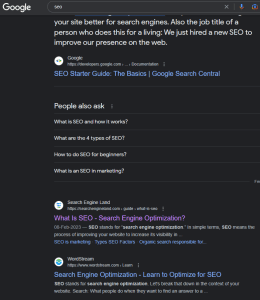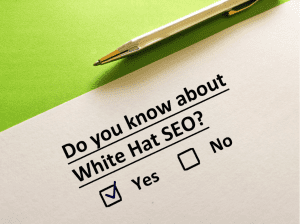Search Engine Optimization (SEO) is the way to make your website and its content better so that it can appear higher in search results when someone searches for something on search engines like Google.
Simply put, it involves making changes to your website and creating content that helps search engines like Google understand what your site is about and display it to users who are searching for relevant information or products.
SEO can help increase your website’s visibility in search results and drive more traffic to your site.
Why SEO is Important in Digital Marketing
In today’s world of technology, businesses use the internet to reach their audiences, no matter the size of the company.
In the digital world today, having a powerful online presence is necessary to make yourself ahead of competitors.
This is where search engine optimization comes in.
SEO plays a critical role in digital marketing by helping businesses increase their visibility in search engine results pages (SERPs), drive more traffic to their websites, and ultimately, increase their revenue.
Now let’s understand..
What is a SERP?
When you search for something on Google or another search engine, you’ll see a list of results on a page known as a search engine results page (SERP).

The results are ranked based on how relevant and useful they are to the user’s search query, and the goal of SEO is to get your website to appear as high up on the SERP as possible.
SERPs typically include a mix of organic search results (which are based on SEO efforts) and paid search results (which are paid for by businesses to appear at the top of the page).
How Search Engines Rank Your Website
Now that we’ve covered the basics of search engine optimization and SERPs, let’s dive into how search engines rank websites and the role that SEO plays in the process.
The Process of Search Engine Ranking
Search engines like Google use complicated formulas known as algorithms to evaluate and arrange websites based on several factors.
Here’s a simplified explanation of how it functions:
Crawling: The search engine sends out “spiders” or “crawlers” to scan the internet and find new web pages. These spiders start by crawling popular pages and then follow links to other pages, building a map of the internet as they go.
Indexing: Once a page has been found, it is “indexed,” which means that the search engine creates a copy of the page and stores it in its database. The index includes information about the page’s content, keywords, and other important factors that the algorithm uses to determine relevance.
Ranking: When a user enters a search query, the search engine’s algorithm goes through the index to find the most relevant pages. The algorithm takes into account hundreds of different signals, including the content on the page, the quality of the backlinks, and the user experience of the site. The algorithm then ranks the pages in order of relevance and quality, and displays them on the search engine results page (SERP).
SEO is all about optimizing your website to meet the requirements of these search engine algorithms.
Want to learn more about SEO and how it can help your website rank higher in search engine results? Check out this video:
Now..
Before you start your journey in SEO field, it’s important to understand the two main types of SEO practices: white hat and black hat.
White Hat SEO

White hat SEO is a set of ethical techniques that follow the guidelines and rules set by search engines to improve the ranking of a website.
These techniques focus on creating high-quality content, optimizing website structure and design, and building high-quality backlinks.
White hat SEO takes time and effort, but it provides long-term benefits and helps to establish trust and credibility with both search engines and users.
Black Hat SEO

Black hat SEO, on the other hand, is a set of unethical techniques that violate the guidelines set by search engines to manipulate rankings and visibility of a website.
These techniques may include keyword stuffing, cloaking, link schemes, and other practices that are deemed unethical and illegal.
Black hat SEO can provide quick results, but it carries significant risks, including penalties, fines, and even getting banned from search engine results.
It’s important to remember that using black hat techniques can have severe consequences and should be avoided at all costs.
So always focus on ethical white hat SEO practices to improve your website’s ranking and visibility in the long run.
Now that we’ve covered the basics of SEO, let’s take a closer look at the different types of SEO strategies that you can use to improve your website’s visibility and rank higher on search engine results pages (SERP).
Types of SEO
- On-Page SEO
- Off-Page SEO
- Technical SEO
- Local SEO
On-Page SEO
On-page SEO refers to optimizing individual pages of your website to rank higher and get more traffic.
It involves making changes to the elements on your website.
Here are some of the key elements that can be optimized for on-page SEO:
- Content: Creating high-quality, relevant, and engaging content that includes targeted keywords.
- Title tags: Writing unique and descriptive title tags that accurately reflect the content of the page.
- Meta descriptions: Creating compelling and informative meta descriptions that provide a summary of the page content.
- Header tags: Using header tags (H1, H2, H3) to organize the content and make it easier to read.
- URL structure: Creating SEO-friendly URLs that are short, descriptive, and easy to understand.
- Internal linking: Linking to other pages within your website to help search engines understand the structure and hierarchy of your content.
- Image optimization: Optimizing images by using descriptive alt tags and file names, compressing images for faster loading, and reducing file sizes.
By optimizing these on-page elements, you can improve your website’s visibility and make it easier for search engines to understand your content, which can lead to higher rankings and more traffic.
Off-Page SEO
Off-page SEO refers to activities that are done outside of your website to improve its visibility and authority.
This involves link building, social media marketing, and other promotional activities.
Here are some essential off-page SEO activities:
- Social media marketing
- Influencer outreach
- Guest blogging
- Online directories
- Brand mentions
- Forums and communities
- Social bookmarking
- PR
By implementing these off-page SEO activities, you can improve your website’s authority and reputation, which can lead to higher rankings and more traffic.
Technical SEO
Technical SEO means optimizing your website’s technical elements to increase its ranking on search engines.
Here are some of the key technical SEO elements that can be optimized:
- Website speed: Ensuring that your website loads quickly and smoothly.
- Mobile responsiveness: Ensuring that your website is mobile-friendly and can be accessed on different devices.
- Site architecture: Structuring your website in a logical and organized way to make it easier for search engines to understand.
- URL structure: Ensuring that your URLs are clear, concise, and easy to understand.
- Site security: Ensuring that your website is secure and uses HTTPS encryption.
- Schema markup: Implementing schema markup to help search engines understand your content and display rich snippets in search results.
- XML sitemap: Creating an XML sitemap to help search engines crawl and index your website.
Local SEO
Local SEO refers to the process of optimizing your website to rank higher in local search results, such as when someone searches for a local business or service in their area.
Some of the key elements that you can optimize for local SEO are:
- Google My Business: Creating and optimizing your Google My Business listing, which includes your business name, address, phone number, and other details.
- Local keywords: Using local keywords in your website content, such as city names or neighborhood names.
- Local backlinks: Getting backlinks from other local businesses or organizations to your website.
- Online directories: Listing your business on online directories such as Yelp, Yellow Pages, or Angie’s List.
- Reviews: Encouraging customers to leave reviews on Google and other review sites to improve your online reputation and local search visibility.
Let’s now discuss one of the most crucial components of SEO – keyword research.
Keyword Research

Keyword research means finding and studying the words that people type when they want to search for something on the internet. This helps your website to be more easily found by people who are looking for information on that topic.
It is an important part of SEO because by targeting the right keywords, you can improve your website’s visibility in search results and attract more relevant traffic to your site.
The goal of keyword research is to find keywords that are relevant to your business or website, have a high search volume, and have low competition.
By using keyword research tools and analyzing search trends, you can identify the best keywords to target and improve your website’s search engine visibility.
Different types of keywords
- Short-tail keywords: These are shorter, more general keywords that typically have a higher search volume but are also more competitive.
- Long-tail keywords: These are longer, more specific keywords that often have a lower search volume but are also less competitive.
- LSI keywords: LSI stands for “Latent Semantic Indexing,” and refers to keywords that are semantically related to your main keyword.
- Branded keywords: keywords that include brand name or variations of it.
- Product keywords: These are keywords that are relevant to the particular products or services.
- Location-based keywords: These are keywords that include a location, such as a city or region.
- Intent-based keywords: These are keywords that are focused on the intent of the searcher, such as informational, or navigational
Having an understanding of SEO overview is great. As a beginner, you may have questions about the tools available for SEO.

Take advantage of these essential SEO tools to analyze your website, conduct keyword research, and analyze your backlinks to improve your online presence.
- Google Analytics
- Google Search Console
- SEMrush
- Ahrefs
- Moz
- Yoast SEO
- Screaming Frog
- SEO minions
- SERPstat
- Ubersuggest
- DeepCrawl
- Google Keyword Planner
- KWFinder
Note: this is not a comprehensive list, as there are many more SEO tools out there to choose from. It’s important to find the ones that work best for your specific needs and goals.


